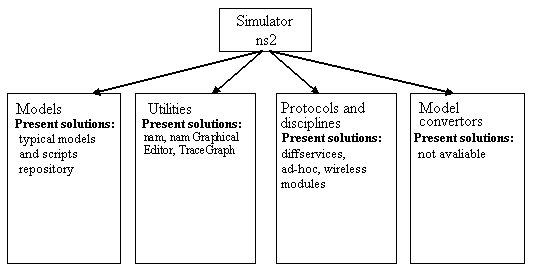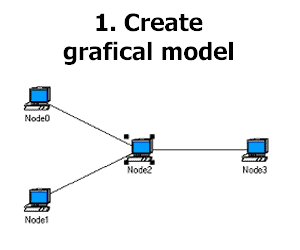Urgency of the master’s work
Network simulator ns2 is the tool most adapted for network research and educational purposes. In this case simplicity of use is extremely important. One of the goals of this project is to archive the simplification of simulator use.
The efficiency of building and use of network became an extremely urgent task. Low price of its designing, its conformity and scalability serve as a criterion for its efficiency. Networks are a basis of all information systems of the business often. So the requirements to network performance considerably grow. Cost of the network building, extending and support grows too.
Use of simulation often becomes an optimal choice in the given situation. Cost of this solution can change in enough wide limits according to software which is in use. In cases when ns2 is using this project can help in studying to work with simulator.
Models need analyzing. This project allows turning on model statistics and researcher have not to add to simulator new expensive modules. This allows to use a maximum of opportunities given by ns2 and not to be limited by standard simulator opportunities [2].
Goals of the master’s work
There are some ways to extend network simulator ns2 (Figure 1):
1) network models creation and analysis, modernization and elimination of network defects using simulation;
2) additional tools development on purpose to receive statistics of model, to calculate parameters, to analyze bottle-necks of simulated topology, etc;
3) core development, new protocols, queuing disciplines, traffic models, application, etc.;
4) converting utilities development.

Figure 1 - Ways to extend network simulator ns2
The ways 3 and 4 are most complicated and require a lot of time to research a simulator’s structure. So the combination of ways 1 and 2 was chosen. Development of tool to simplify using ns2 and typical models for it is a goal of the project [2].
This tool should provide graphical user interface for network simulation using simulator ns2. Now GUI became the integral part of many applications. The availability of the graphic interface at a simulator considerably simplifies model building and analyzing. Network simulator 2 have only a scripting interface therefore this work may become one of the first similar tools.
The system should provide a possibility to assign model characteristics:
- LAN, WAN networks;
- various link parameters (throughput, delay, type, queue size);
- type of traffic, size of packets;
- object monitors, etc.
Possibility to save and load model is important too. The system should have an object-based design.
Fuctions of the application:
- providing GUI for simulation;
- converting model from graphical to script notation;
- running ns2 with parameters;
- analyzing results.
Figure 2 shows the simulation steps.

Figure 2 - Simulation steps
Present solutions overview
Network Simulator 2 is a discrete event simulator targeted at networking research. It provides support for simulation of TCP/IP stack protocols, routing and multicast protocols over wired and wireless networks. In addition, ns2
incorporates a range of link-layer topologies and scheduling and queue management algorithms. Ns2 is an open-source project and can be used for non-commercial use free of charge. Simulator is installable from source or package formats on popular desktop and server platforms, such as Unix-like OS and MS Windows [3].
The simulator ns2 and the graphic interpreter nam are widely used for educational purposes for protocol testing and inplementation in universities of Europe and USA. There are the script repository include for example realization of “sliding window” and “slow start” mechanismes of TCP, queue management disciplines, etc.
In order to be able to calculate the results from the simulations, the data has to be collected somehow. Ns2 supports two primary monitoring capabilities:
- traces. The traces enable recording of packets whenever an event such as packet drop or arrival occurs in a queue or a link.
- and monitors. The monitors provide a means for collecting quantities, such as number of packet drops or number of arrived packets in the queue. The monitor can be used to collect these quantities for all packets or just for a specified flow (a flow monitor) [4].
Simulator’s facilities and extensibility cause arising the majority of simulator- based projects. Now ns2 contains some useful utilities which include e.g.:
- Tcl debugger. Tcl debugger is used to debug Tcl scripts and it might become necessary if one is using large scripts to control a simulation. Tcl-debug is not however installed automatically with NS2 but it can be installed later. One drawback of using Tcl-debug is that it is dependent on used Tcl version and also NS2 version;
- simulation scenario generator. For topology generation there are four choices : NTG, RTG, GT-ITM and TIERS packages. At least GT-ITM is part of the NS2 distribution. It requires Knuth's cweb and SGB software to work together with NS2, but these software packages are also part of the NS2 distribution. With these topology generators one can create large network topologies without the need to define the whole topology by hand;
- simulation topology generator. Simulation scenario generator can be used to create traffic between nodes. When simulating wireless networks, the scenario generator can also be used to generate files that define the movement of nodes [5].
All existing development provides functions allow using simulator features more effectively. There are utilities for graphic creation of models, animation and analysis of results of modeling.
While ns2 has been funded by a number of previous research projects, no funding has been in place since 2004, and none directly as an infrastructure project since 2000. Some researchers and their respective institutions (University of Washington, Georgia Institute of Technology, and the ICSI Center for Internet Research), with collaborative support from the Planete research group at INRIA Sophia-Antipolis, have developed a four-year, NSF-funded program about to develop a new major version of the simulator, called ns version 3 (ns3).
There are main goals of the project:
- re-architect the simulator for better ease of use, scalability (principally by class redesign, natively supporting multiprocessor and distributed simulations, and support for 64-bit machines), and support for integration of other software;
- the simulator should easily, with realistic models at different levels of abstraction, allow for simulations of IPv4 and IPv6 networks, as well as novel, research-oriented network architectures;
- core models should be well tested, validated and documented;
- the project should develop a set of canonical simulation-based experiments for use in networking courseware [6].
The nam Graphical Editor is the latest addition to network animator nam. With the nam editor, user no longer have to type TCL code to create animations and can create network topology and simulate various protocols and traffic sources by dragging the mouse [7]. The nam Graphical Editor should be installed in Unix-like operation systems. According to Internet resources analysis the Graphical Editor is not in very popular tool.
There are some tools for simulation results analysis. Trace graph was developed by Jaroslaw Malek in 2003. Trace graph is a free network trace files analyzer developed for network simulator ns-2 trace processing. Tool support any trace format if converted to its own or ns-2 trace format. Trace graph runs under Windows, Linux, UNIX and MAC OS systems.
Some of the program features:
- 238 2D graphs;
- 12 3D graphs;
- delays, jitter, processing times, round trip times, throughput graphs and statistics;
- whole network, link and node graphs and statistics;
- all the results can be saved to text files, graphs can also be saved as jpeg and tiff;
- x, y, z axes information: minimum, mean, maximum, standard deviation, median;
- any graph saved in text file with 2 or 3 columns can be plotted;
- script files processing to do the analysis automatically.
Also more specific solutions which add to simulator new elements: protocols, traffic generators, algorithms etc exist. A set of projects research various aspects of computer networks (protocols, queue management disciplines, etc.) and various networks configurations (wireless, differentiated services, ad-hoc networks, etc.).
References
1. Gilberto Flores Lucio, Marcos Paredes-Farrera, Emmanuel Jammeh. OPNET Modeler and Ns-2: Comparing the Accuracy Of Network Simulators for Packet-Level Analysis using a Network Testbed, University of Essex, Colchester, Essex, United Kingdom, 2002.
2. Ерыгина Т.П., Аноприенко А.Я. Разработка графической среды для создания моделей для сетевого симулятора NS2 // Информатика и компьютерные технологии 2006: материалы второй региональной студенческой научно-технической конференции. г. Донецк, 13 декабря 2006 г.
3. Ерыгина Т.П., Аноприенко А.Я. Применение средства моделирования вычислительных сетей NS2 в исследовательских и учебных целях // Информатика и компьютерные технологии 2005: материалы первой региональной студенческой научно-технической конференции. г. Донецк, 15 декабря 2005 г.
4. Sandeep Bajaj, Lee Breslau, Deborah Estrin. Improving Simulation for Network Research, USC Computer Science Department, 1999.
5. Кучерявый Е.А.
NS2 как универсальное средство имитационного моделирования сетей связи, Tampere University of Technology, Telecommunications Laboratory, Tampere, Finland, 2001.
6. Thomas R. Henderson, Sally Floyd, George F. Riley. NS-3 Project Goals, Department of Electrical Engineering, University of Washington, Seattle, Washington, 2006.
7. Deborah Estrin, Mark Handley, John Heidemann
Network Visualization with the VINT Network Animator Nam, USC Computer Science Department Technical Report 99-703b, 1999.